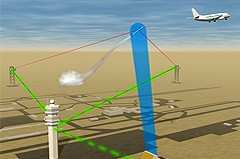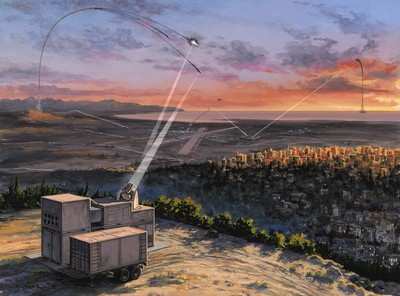Tue, Oct 24, 2006
Which is Better: Ray Gun Or Laser?
 If you hear the
expression "shields up", you may not be watching a science fiction
movie, where those invisible shields are activated to protect
the spaceship. You might be observing the competition between
Raytheon and Northrop-Grumman to protect an airport near you from
terrorist MANPADS (man-portable-air-defense-missiles), such as the
Stinger.
If you hear the
expression "shields up", you may not be watching a science fiction
movie, where those invisible shields are activated to protect
the spaceship. You might be observing the competition between
Raytheon and Northrop-Grumman to protect an airport near you from
terrorist MANPADS (man-portable-air-defense-missiles), such as the
Stinger.
Both companies have won contracts to study the feasibility of
protecting airports from the ground, rather than trying to equip
each airplane with its own portable device.
Raytheon has a four million dollar contract from the Department
of Homeland Security to study and design its Vigilant Eagle
Airport Protection System.
The system will aim a focused beam of electromagnetic
energy at the terrorist missile causing it to go blind and off
course. If it works, there will be a virtual invisible dome over
the airport protecting all arriving and departing aircraft from the
threat.
"Raytheon's Vigilant Eagle defeats man-portable missiles in
seconds without any alteration to or involvement by the aircraft
using the airport," said Mike Booen, vice president of Directed
Energy Weapons at Raytheon Missile Systems.
In the meantime, Northrop Grumman has a $2 million contract
to build a laser-based system to do the same thing. Called
Skyguard, this program uses high energy lasers to not only shoot
down missiles, but Northrop Grumman claims it can also knock down
artillery shells and mortars.
"The ability of a high-energy laser to shoot down rockets,
artillery and mortars has been demonstrated repeatedly with mature
chemical laser technologies" said Alexis Livanos, Space Technology
president. "Skyguard will be a revolutionary approach to aviation
security because it's based on the only laser system that has shot
down a wide variety of airborne threats in flight. Northrop Grumman
is the only company that has built a deployable high-energy laser
weapon system that has destroyed such targets."

Vigilant Eagle vs. Skyguard -- ray gun vs. laser --
sounds like Star Trek vs. Star Wars.
More News
Inversion to Launch Reentry Vehicle Demonstrator Aboard SpaceX Falcon 9 This fall, the aerospace startup Inversion is set to launch its Ray reentry demonstrator capsule aboard Spac>[...]
"We are excited to accelerate the adoption of electric aviation technology and further our journey towards a sustainable future. The agreement with magniX underscores our commitmen>[...]
"The journey to this achievement started nearly a decade ago when a freshly commissioned Gentry, driven by a fascination with new technologies and a desire to contribute significan>[...]
Aero Linx: OX5 Aviation Pioneers Each year a national reunion of OX5 Aviation Pioneers is hosted by one of the Wings in the organization. The reunions attract much attention as man>[...]
"Our driven and innovative team of military and civilian Airmen delivers combat power daily, ensuring our nation is ready today and tomorrow." Source: General Duke Richardson, AFMC>[...]
 SpaceX to Launch Inversion RAY Reentry Vehicle in Fall
SpaceX to Launch Inversion RAY Reentry Vehicle in Fall Aero-News: Quote of the Day (04.23.24)
Aero-News: Quote of the Day (04.23.24) Aero-News: Quote of the Day (04.20.24)
Aero-News: Quote of the Day (04.20.24) ANN's Daily Aero-Linx (04.20.24)
ANN's Daily Aero-Linx (04.20.24) Aero-News: Quote of the Day (04.21.24)
Aero-News: Quote of the Day (04.21.24)




